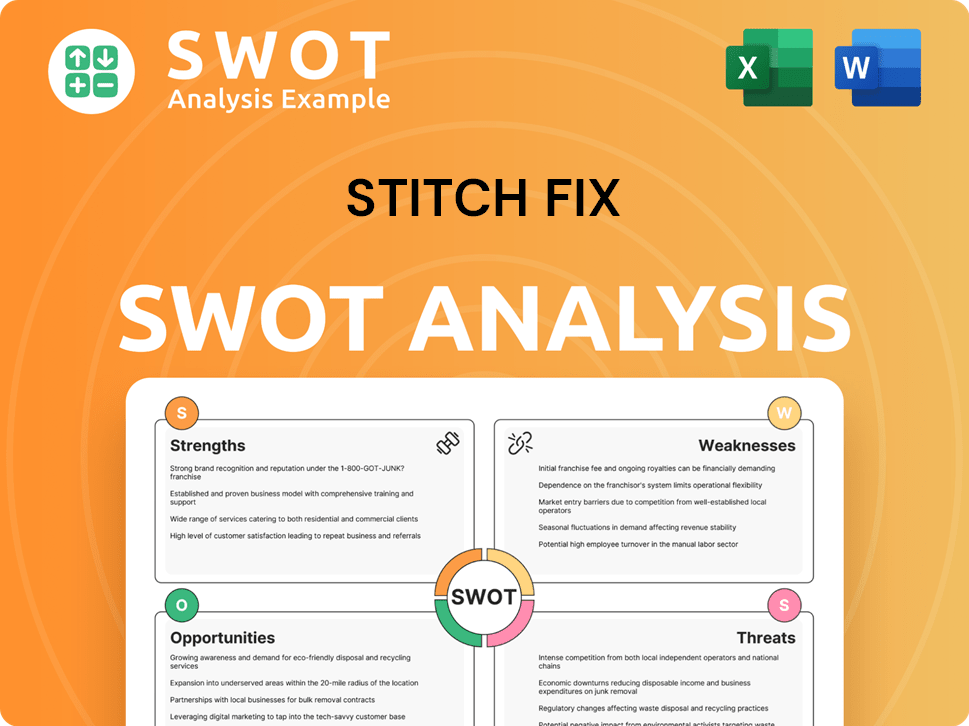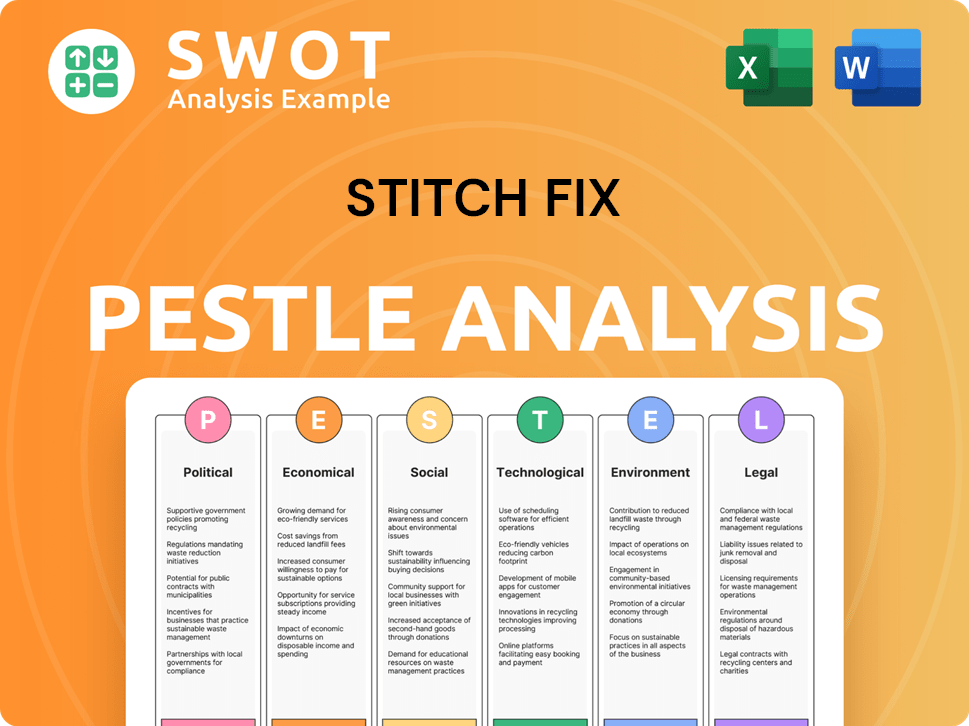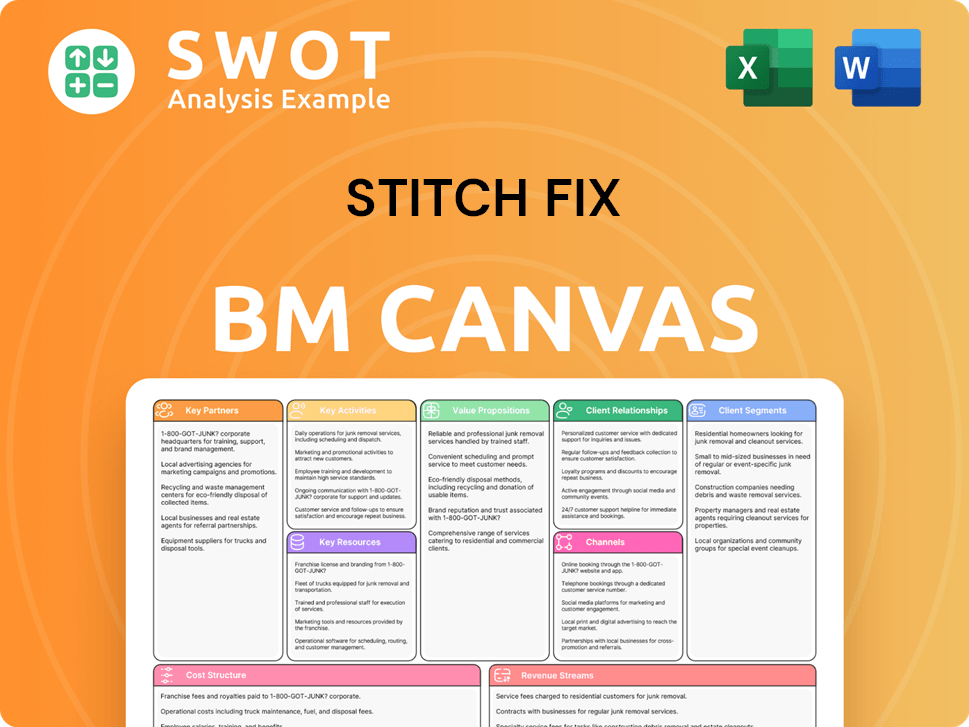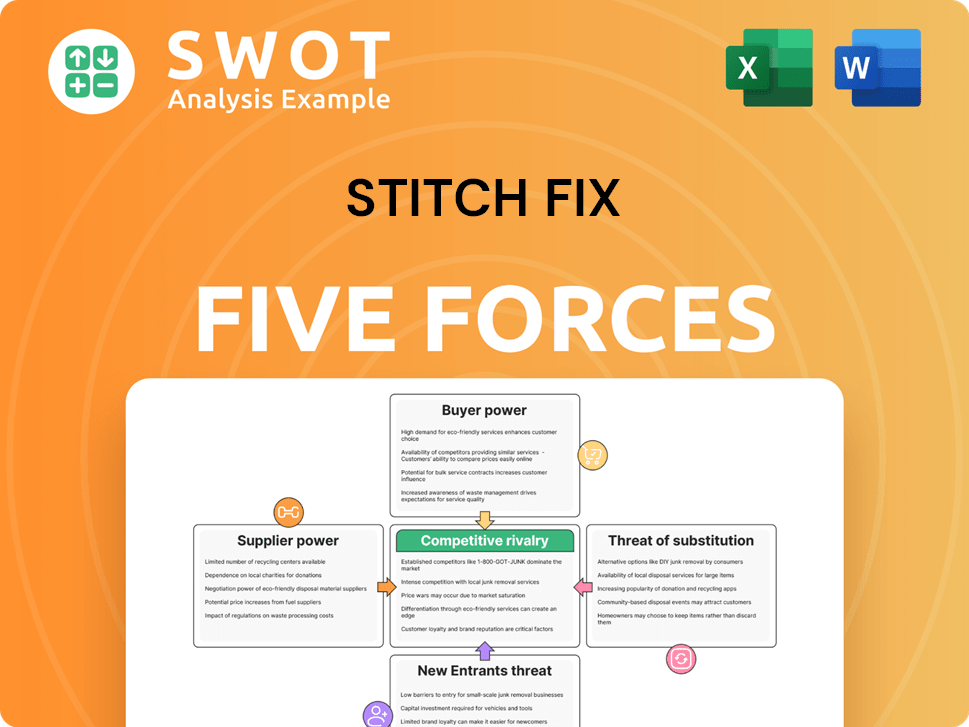Stitch Fix Bundle
Can Stitch Fix Maintain Its Edge in the Competitive Fashion Arena?
Stitch Fix revolutionized the retail fashion industry by blending technology with personalized styling, offering curated apparel boxes directly to customers. Founded in 2011, the company quickly gained traction, addressing the limitations of traditional retail and e-commerce through a unique, data-driven approach. This innovative model allowed customers to enjoy a convenient and tailored shopping experience, setting a new standard in the industry.

As of early 2024, understanding the Stitch Fix SWOT Analysis is crucial for grasping its position within the dynamic Stitch Fix competitive landscape. This analysis will delve into Stitch Fix competitors, examining their strategies, market share, and how Stitch Fix differentiates itself. Furthermore, a thorough Stitch Fix market analysis will highlight the company's ability to adapt and innovate amidst evolving consumer expectations and industry trends, including online styling services and fashion subscription boxes.
Where Does Stitch Fix’ Stand in the Current Market?
The company operates within the dynamic online personal styling and apparel retail sectors. Its market position has been significantly shaped by evolving consumer behaviors and the rise of competition. The business model revolves around personalized apparel, accessories, and shoes for women, men, and kids, primarily through its 'Fix' subscription service and the direct-buy 'Freestyle' option.
Geographically, the company primarily serves customers in the United States and the United Kingdom. Initially, it pioneered the subscription-box model for personalized styling, establishing itself as a leader in this emerging market. However, increased competition and broader e-commerce trends have prompted diversification.
The introduction of Freestyle in 2021 allowed customers to shop directly from a personalized online store without needing a Fix, aiming to capture a larger share of the online apparel market. The Stitch Fix competitive landscape has evolved, requiring the company to adapt its strategies to maintain its market position. For a deeper dive into the company's ownership structure, you can explore Owners & Shareholders of Stitch Fix.
Specific market share figures for the 'online personal styling' niche are not always readily available or consistently reported. However, the company has historically been a prominent player in this segment. Its initial success was built on pioneering the subscription-box model for personalized styling, which helped it gain a significant foothold in the market.
The company's financial performance indicates a weaker position compared to its peak. For the second quarter of fiscal year 2024, net revenue was $364.9 million, a decrease of 18% year-over-year. The active client count also decreased to 2,800,000 as of January 27, 2024, down 17% year-over-year. These figures reflect the pressures of a challenging retail environment.
To regain momentum, the company has diversified its offerings, including the introduction of Freestyle in 2021. This move aimed to broaden its appeal beyond the subscription model. The company is likely focusing on customer acquisition strategies and refining its revenue streams to adapt to the evolving Stitch Fix market analysis.
The company operates within the fashion industry, which is subject to changing consumer preferences and trends. The future outlook depends on its ability to adapt to these trends and maintain a competitive edge. Understanding the Stitch Fix competitors and the broader online styling services market is crucial for assessing its long-term prospects.
The company faces several challenges in maintaining its market position. These include increased competition from both established retailers and new entrants in the online styling space. The company's financial performance, with declining revenue and active clients, highlights the need for strategic adjustments.
- Adapting to changing consumer preferences and fashion trends.
- Competing with established retailers and new entrants in the online styling market.
- Improving customer acquisition and retention strategies.
- Optimizing the Freestyle model to drive revenue growth.
Stitch Fix SWOT Analysis
- Complete SWOT Breakdown
- Fully Customizable
- Editable in Excel & Word
- Professional Formatting
- Investor-Ready Format

Who Are the Main Competitors Challenging Stitch Fix?
Analyzing the Brief History of Stitch Fix reveals a dynamic competitive landscape. The company faces competition from various players in the fashion and retail industries, each vying for market share in the personalized shopping and online styling services sectors. Understanding these competitors is crucial for assessing the company's position and future prospects.
The competitive environment for the company is multifaceted, encompassing direct competitors offering similar services and indirect competitors from broader retail segments. The fashion industry's evolution, coupled with technological advancements, has intensified the competition, necessitating continuous adaptation and innovation.
The company's market analysis reveals a complex interplay of factors influencing its competitive standing. Key aspects include the rise of e-commerce, the demand for personalized experiences, and the impact of fast fashion trends. These forces shape the strategies and performance of all players in the market.
Direct competitors in the online personal styling space include services that offer curated boxes and personalized styling. These services directly challenge the company on convenience, personalization algorithms, and the quality of their styling.
Wantable provides curated boxes for various styles and occasions, competing directly with the company in the personalized styling market. It focuses on delivering a tailored shopping experience.
Nordstrom's Trunk Club leverages the established brand and extensive inventory of Nordstrom to provide personalized styling. It focuses on higher-end fashion, competing for a different segment of the market.
Indirect competitors include large e-commerce platforms and fast-fashion retailers. These competitors offer vast selections, competitive pricing, and rapid trend cycles, posing a broader threat to the company's market share.
Amazon offers vast selections and competitive pricing, competing with the company through its extensive e-commerce platform. It has expanded into personalized shopping with services like Amazon Personal Shopper.
Zappos is known for its extensive shoe and apparel offerings and strong customer service. It competes by providing a wide selection and a focus on customer satisfaction.
The competitive landscape is also influenced by emerging players and market trends. Direct-to-consumer (DTC) brands and rental services are adding new dimensions to the competition, forcing existing players to adapt.
- Direct-to-Consumer (DTC) Brands: Specializing in specific apparel categories or sustainable fashion, these brands offer niche alternatives.
- Rental Services: Services like Rent the Runway cater to consumers seeking variety without ownership.
- Mergers and Alliances: Acquisitions of smaller styling services by larger retail groups could reshape the competitive dynamics.
- AI and Personalization: Emerging players leveraging AI for more granular personalization.
Stitch Fix PESTLE Analysis
- Covers All 6 PESTLE Categories
- No Research Needed – Save Hours of Work
- Built by Experts, Trusted by Consultants
- Instant Download, Ready to Use
- 100% Editable, Fully Customizable

What Gives Stitch Fix a Competitive Edge Over Its Rivals?
Analyzing the Growth Strategy of Stitch Fix, it's clear that the company's competitive advantages are rooted in its unique blend of data science and human expertise. This hybrid model allows for highly personalized clothing selections, addressing the common consumer pain points of decision fatigue and the challenge of finding well-fitting and stylish clothing. The company's early mover status in the online personal styling space has also fostered significant brand equity and customer loyalty.
The core of its competitive edge lies in its proprietary algorithms, which analyze a vast array of customer data points to generate personalized clothing selections. This data-driven approach enables a level of personalization that traditional retail struggles to match. The integration of human stylists further enhances the customer experience, providing a sense of human connection and expert validation that purely algorithmic services lack. This combination creates a unique value proposition in the competitive landscape.
Furthermore, the convenient home delivery and try-before-you-buy model represent a strong operational advantage, simplifying the shopping process for customers. While facing recent challenges, its investment in technology, such as its Style Profile and inventory management systems, continues to be a foundational strength. These advantages have evolved from simply offering a novel service to becoming a sophisticated operation capable of managing complex logistics and diverse customer preferences at scale, impacting its market analysis.
Stitch Fix uses proprietary algorithms to analyze customer data, including size, style preferences, and feedback. This allows for highly personalized clothing selections, setting it apart from traditional retailers. The algorithms are continually refined, enhancing the accuracy and relevance of the recommendations.
Human stylists review algorithm-generated selections and add their personal touch, enhancing the customer experience. This blend of technology and human expertise provides a sense of connection and expert validation. This differentiates Stitch Fix from purely algorithmic services.
The try-before-you-buy model and home delivery simplify the shopping process. This convenience addresses consumer pain points like decision fatigue and the challenge of finding well-fitting clothing. This operational efficiency contributes to customer satisfaction.
As an early mover in the online personal styling space, Stitch Fix has built significant brand equity. This has fostered customer loyalty among its long-standing users. The brand's reputation for personalized service and convenience contributes to its competitive advantage.
Stitch Fix's strengths include its data-driven personalization, hybrid model, convenient shopping experience, and established brand equity. These advantages help it compete in the fashion subscription box market. However, the company faces challenges from competitors and evolving technologies.
- Data-Driven Personalization: Proprietary algorithms analyze customer data for customized selections.
- Hybrid Model: Combining algorithms with human stylists enhances the customer experience.
- Convenience: Home delivery and try-before-you-buy simplify the shopping process.
- Brand Equity: Early mover advantage and customer loyalty.
Stitch Fix Business Model Canvas
- Complete 9-Block Business Model Canvas
- Effortlessly Communicate Your Business Strategy
- Investor-Ready BMC Format
- 100% Editable and Customizable
- Clear and Structured Layout

What Industry Trends Are Reshaping Stitch Fix’s Competitive Landscape?
The Stitch Fix competitive landscape is shaped by evolving industry dynamics, with technology playing a key role in personalization and customer expectations. The market is also influenced by changing consumer preferences towards convenience, sustainability, and ethical production, alongside a sustained demand for value. These factors present both challenges and opportunities for the company.
The primary risks involve the increasing sophistication of AI in competing platforms, potentially eroding the company's advantage. Heightened competition from established retailers and new direct-to-consumer brands also poses a threat. Economic uncertainties and inflationary pressures could affect discretionary spending on apparel, influencing revenue and the active client base. However, opportunities exist in expanding into new demographics or geographic markets and refining product assortment.
Technological advancements, particularly in AI and machine learning, continue to drive more sophisticated personalization capabilities across the retail sector. Consumer preferences are shifting towards greater convenience, sustainability, and ethical production, alongside a continued demand for value. Regulatory changes related to data privacy and sustainability are also influencing business practices.
The increasing sophistication of AI in competing platforms could erode the company's advantage in personalization. Heightened competition from both established retailers and new direct-to-consumer brands poses a threat to market share. Economic uncertainties and inflationary pressures may impact discretionary spending on apparel, affecting revenue and active client base.
The growing consumer demand for personalized experiences can be further leveraged through enhanced data science and stylist interactions. Opportunities exist in expanding into new demographics or geographic markets. Refining its product assortment to align with sustainability preferences can also create opportunities. Strategic partnerships with complementary brands or technologies could also be beneficial.
The company will likely focus on continuing to refine its technology, optimizing its inventory management, and fostering deeper customer engagement. The Freestyle offering represents an attempt to capture a broader market by moving beyond the pure subscription model. A blend of human and artificial intelligence will be key.
To maintain its position in the Stitch Fix market analysis, the company must address several key areas. The need to compete with advanced AI capabilities from competitors is critical. Expanding into new markets and refining product offerings to meet evolving consumer demands are also essential.
- Enhance personalization algorithms to stay ahead of competitors.
- Explore new geographic markets and customer segments.
- Adapt product offerings to align with sustainability trends.
- Optimize inventory management and supply chain efficiency.
Stitch Fix Porter's Five Forces Analysis
- Covers All 5 Competitive Forces in Detail
- Structured for Consultants, Students, and Founders
- 100% Editable in Microsoft Word & Excel
- Instant Digital Download – Use Immediately
- Compatible with Mac & PC – Fully Unlocked

Related Blogs
- What are Mission Vision & Core Values of Stitch Fix Company?
- What is Growth Strategy and Future Prospects of Stitch Fix Company?
- How Does Stitch Fix Company Work?
- What is Sales and Marketing Strategy of Stitch Fix Company?
- What is Brief History of Stitch Fix Company?
- Who Owns Stitch Fix Company?
- What is Customer Demographics and Target Market of Stitch Fix Company?
Disclaimer
All information, articles, and product details provided on this website are for general informational and educational purposes only. We do not claim any ownership over, nor do we intend to infringe upon, any trademarks, copyrights, logos, brand names, or other intellectual property mentioned or depicted on this site. Such intellectual property remains the property of its respective owners, and any references here are made solely for identification or informational purposes, without implying any affiliation, endorsement, or partnership.
We make no representations or warranties, express or implied, regarding the accuracy, completeness, or suitability of any content or products presented. Nothing on this website should be construed as legal, tax, investment, financial, medical, or other professional advice. In addition, no part of this site—including articles or product references—constitutes a solicitation, recommendation, endorsement, advertisement, or offer to buy or sell any securities, franchises, or other financial instruments, particularly in jurisdictions where such activity would be unlawful.
All content is of a general nature and may not address the specific circumstances of any individual or entity. It is not a substitute for professional advice or services. Any actions you take based on the information provided here are strictly at your own risk. You accept full responsibility for any decisions or outcomes arising from your use of this website and agree to release us from any liability in connection with your use of, or reliance upon, the content or products found herein.